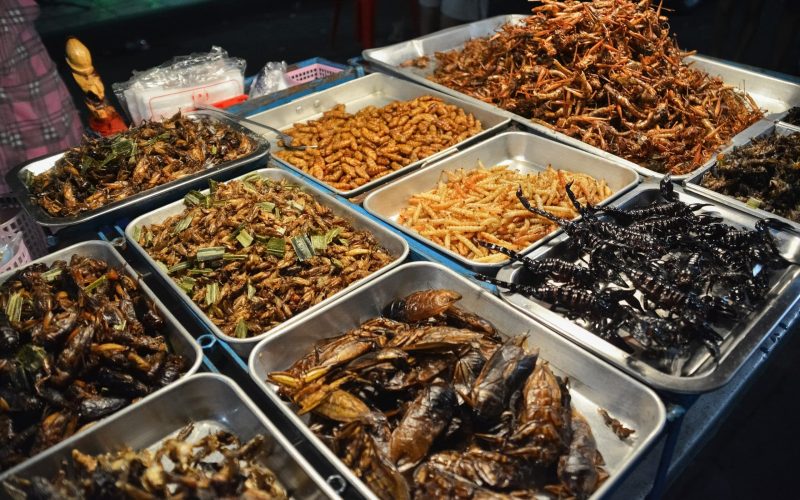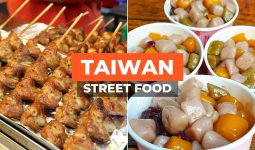This article discusses some of the different types of insects that people eat worldwide.
Insects are often considered pests or creepy crawlies that we try to avoid at all costs.
However, in many cultures worldwide, insects are considered a sweet delicacy and an important source of protein.
While eating insects might make some people squeamish, it’s a sustainable and eco-friendly way to supplement our diets.
In this article, we’ll explore the different types of insects that people eat, the nutritional benefits of incorporating them into our diets, and some delicious ways to prepare them.
1. Ants

Ants are another type of insect that is wholly consumed in many cultures around the world.
Over 1,000 ants species are edible and often used in traditional dishes. Ants are rich in protein and nutrients such as iron, calcium, and zinc.
Also, they are low in fat and fiber, making this insect a healthy addition to any diet.
One of the most well-known species of edible ants is the leafcutter ant, commonly found in Central and South America.
These ants are usually roasted or fried and have a nutty flavor. Also, they are often eaten as a snack or added to soups and stews.
Another popular type of edible ant is the weaver ant, which is commonly found in Southeast Asia.
These ants are typically harvested in the wild and are known for their sour and tangy flavor. They are often used in salads and spicy dishes.
In some cultures, ant eggs are also a delicacy. These tiny white eggs are harvested from ant nests and are usually eaten raw or cooked in various dishes.
Also, they have a creamy texture and a slightly nutty flavor.
While the idea of eating ants may seem strange to some people, they are a nutritious and sustainable source of food that has been consumed for thousands of years.
2. Crickets

Crickets which are one of the different types of insects that people eat, are a type of insect that belongs to the famous order Orthoptera and the family Gryllidae.
They are found worldwide, with over 900 species known to science.
Also, Crickets are known for their distinctive chirping sound, produced by the males rubbing their front wings together to attract mates.
Crickets are commonly consumed in many parts of the world, particularly in the larger part of Asia, Africa, and South America.
Also, they are often eaten as a snack or used as an ingredient in various dishes.
Regarding nutritional value, crickets are a good source of protein and contain essential amino acids, vitamins, and minerals.
When cooked, crickets have a nutty flavor and a crunchy texture. They can be eaten roasted, fried, or baked and are often seasoned with salt, spices, or herbs.
In some cultures, crickets are also ground into a powder and used as a high-protein supplement in shakes or smoothies.
While some may be off-eating insects, crickets are becoming increasingly famous as a sustainable and eco-friendly alternative to traditional meat sources.
They require significantly less water, feed, and land to produce than livestock and produce fewer greenhouse gas emissions.
3. Beetles

Beetles, one of the different types of insects that people eat, are a highly diverse group of insects in various sizes, colors, and shapes.
They comprise one of the largest insect groups worldwide, with over 400,000 identified species.
These insects can be found in nearly every habitat, from rainforests to deserts and freshwater to marine environments.
Many cultures worldwide consider beetles a delicacy and a source of protein.
Some edible beetle species include the rhinoceros, dung beetle, and mealworm beetle. Their larvae are also consumed, such as the palm beetle larvae.
Beetles are recognized for their tough exoskeletons, which shield them from predators and help them thrive in harsh environments.
Some beetle species can also fly using their wings to travel for food and mates.
Beetles play a significant ecological role in the ecosystem, helping to break down dead plant and animal matter, pollinate flowers, and control pest populations.
Ladybugs are among the beetle species used in biological pest control to help control agricultural pests.
In conclusion, beetles are an intriguing group of insects with significant ecological and cultural importance.
While not as commonly eaten as other insects, they still form an important part of many people’s diets and have much to offer regarding their ecological roles and cultural significance.
Beetle is one of the different types of insects that people eat.
4. Termites

Termites are social insects belonging to the order Blattodea, including cockroaches.
They are known for their efficient ability to break down and recycle wood and plant material, making them important contributors to the ecosystem.
Termites are widely distributed and live in large colonies with a highly organized social structure.
The primary food source for termites is wood and other plant material, which they break down with the help of microorganisms living in their gut.
However, while they play an important role in the ecosystem, termites can also cause significant damage to homes and other structures, resulting in billions of dollars in damage each year.
Despite their destructive potential, termites are consumed as a snack in different parts of the world.
In some cultures, they are typically fried or roasted and enjoyed as a crunchy delicacy. This is one of the different types of insects that people eat.
5. Grasshoppers

Grasshoppers are a widely consumed insect with a long history of use as a protein source in various cultures.
Belonging to the suborder Caelifera, they are recognizable for their long hind legs and impressive jumping ability.
Apart from their distinctive appearance, grasshoppers are highly nutritious, rich in protein, iron, and essential vitamins and minerals.
Also, they are low in fat and calories, making them an ideal healthy and sustainable food source.
In many countries, grasshoppers are prepared as a crunchy snack, roasted, fried, grilled, or used as an ingredient in various dishes.
For example, in African countries, grasshoppers are commonly harvested in large quantities during the rainy season, then dried, smoked, and sold in local markets.
Latin American countries also enjoy grasshoppers, often serving them with spices and herbs or using them as a protein-rich ingredient in bread and other baked goods. The sustainable nature of grasshoppers is another advantage.
They require little space and resources to raise compared to traditional livestock, making them an eco-friendly source of protein.
Furthermore, harvesting grasshoppers can benefit local communities economically and support small-scale farming.
Although some people hesitate to try insects as a food source, grasshoppers offer a nutritious and sustainable alternative to conventional protein sources.
However, as more people seek ways to reduce their environmental impact and adopt healthier diets, grasshoppers and other edible insects are becoming increasingly popular.
Grasshopper is one of the different types of insects that people eat.
6. Bees

Bees are known for their important role in pollination and honey production, but they are also consumed in many cultures worldwide.
Honeybees, bumblebees, and stingless bees are the most commonly eaten species.
In some countries, bee broods (the larvae and pupae of bees) are a popular delicacy.
They are usually harvested from honeycombs before they develop into adult bees and can be eaten raw or cooked.
Bee brood is high in protein, fat, and minerals and has a nutty, buttery flavor.
Honeybees, on the other hand, are often eaten as a crunchy snack.
They can be deep-fried, roasted, or eaten raw. In some countries, honeybees are also used as a topping for desserts or mixed with spices to create a sweet and savory condiment.
Stingless bee honey, known as “melipona honey,” is highly prized in some cultures for its unique flavor and medicinal properties.
In addition to being used as a cool sweetener, it is also used in traditional medicine to treat various ailments.
In addition, bees are an important part of the ecosystem and should not be consumed excessively; their consumption has been a longstanding tradition in many cultures.
It continues to be enjoyed as a unique culinary experience.
7. Mealworms

Mealworms are considered a sustainable food source as they require less land, water, and food to produce when compared to traditional livestock.
They are also more eco-friendly as they produce fewer greenhouse gases and require fewer resources.
Mealworms are typically consumed in various ways, including roasted, fried, and as a powder.
They have a nutty, earthy taste and can be used in cooking various dishes, including salads, pasta, and baked goods.
In addition to their high protein content, mealworms are a good source of vitamins, carbohydrates, and minerals, including iron, calcium, and B vitamins.
Also, they are low in fat, making them a very good addition to a balanced diet.
Despite the many benefits of mealworms as a food source, some people may still find eating insects unappealing.
However, as awareness grows about edible insects’ sustainability and nutritional benefits, more people may be willing to try them.
Mealworms are one of the different types of insects that people eat.
8. Cicadas

Cicadas are a type of Hemiptera insect commonly found in North America, Europe, and Asia.
The males of the species are known for their distinct buzzing sound, which they produce to attract mates.
Humans have consumed cicadas for centuries, with China, Japan, and Korea being popular countries for cicada consumption.
Cicadas are harvested in the summer when they emerge from the ground after several years of underground development.
They can be boiled, roasted, consumed as a crunchy snack, or used in various dishes.
Cicadas are an excellent source of protein, Carbohydrates, minerals, and vitamins and are low in fat and fiber, making them a sustainable and healthy food source.
However, some species of cicadas can contain toxins and should not be consumed.
Despite this, there has been a surge of interest in cicada consumption in recent years, particularly in the beautiful United States, with a rise in cicada-based products such as snacks, pet food, and cocktails.
Cicadas offer a nutritious and sustainable food source that humans have consumed for centuries and may be widely accepted in the Western world.
9. Waxworms

Waxworms are one of the different types of insects that are the larvae of the wax moth, a common pest of beehives.
These worms are typically used as fishing bait or food for pets like reptiles and birds, but they are also a popular edible insect in some cultures.
Waxworms are high in protein, low in fat, and have a nutty taste and soft, chewy texture.
They are often fried or roasted and can be eaten whole or completely ground into a powder and used as a protein supplement in other foods.
In some places, waxworms are considered delicacies and served in high-end restaurants.
Waxworms can be sustainably farmed and harvested, making them a more environmentally-friendly source of protein than traditional livestock.
They also require less space, water, and feed than many other types of livestock.
Despite their benefits, waxworms may not be suitable for everyone, especially those with allergies to shellfish or other insects.
As with any new food, starting with small portions and monitoring for adverse reactions is important. Waxworm is one of the different types of insects that people eat.
10. Waterbugs
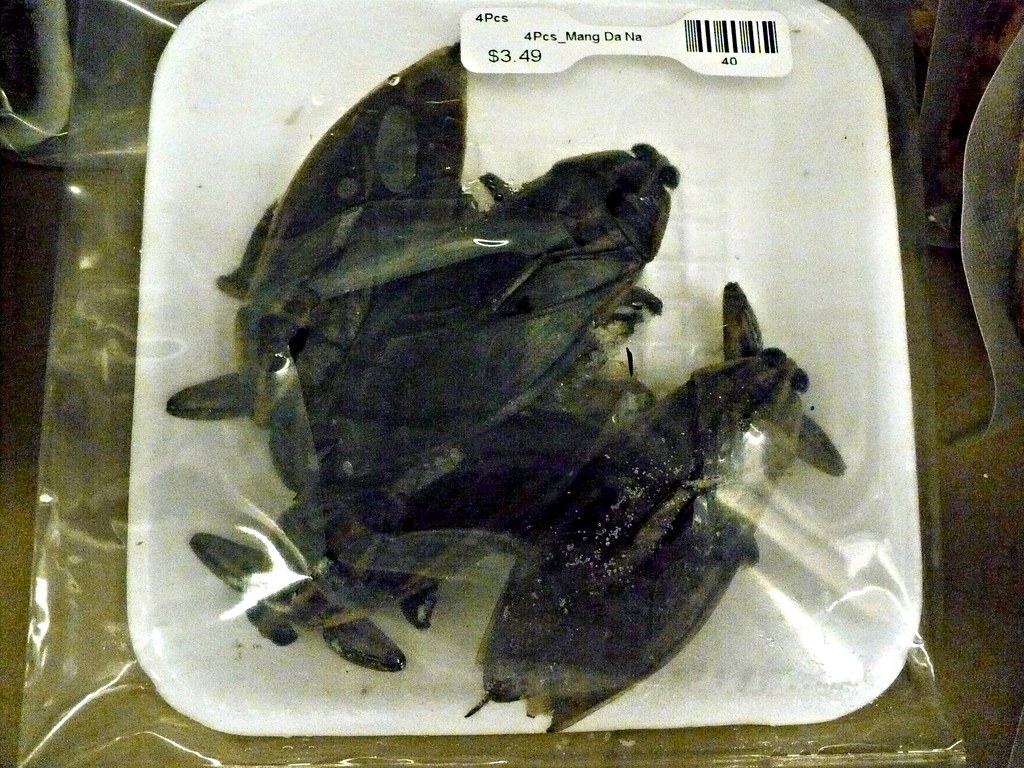
Waterbugs, also known as giant water bugs, are large aquatic insects that are a popular delicacy in Southeast Asia, particularly Thailand and Vietnam.
These insects are from the family Belostomatidae and can range in size from 1.5 to 4 inches.
To prepare waterbugs for consumption, they are typically roasted or deep-fried until crispy, and some people enjoy them raw or pickled.
Waterbugs have a flavor profile similar to shrimp or crab, with a slightly nutty aftertaste.
In addition to being a popular snack, waterbugs are believed to have medicinal properties.
These insects have been used in traditional medicine to treat asthma, fever, and rheumatism.
However, it’s essential to note that waterbugs can be toxic if not prepared correctly because they contain a potent venom that can cause a painful and sometimes dangerous reaction.
Therefore, purchasing waterbugs from a trustworthy source and cooking them thoroughly before consuming them is essential.
11. Bamboo Worms
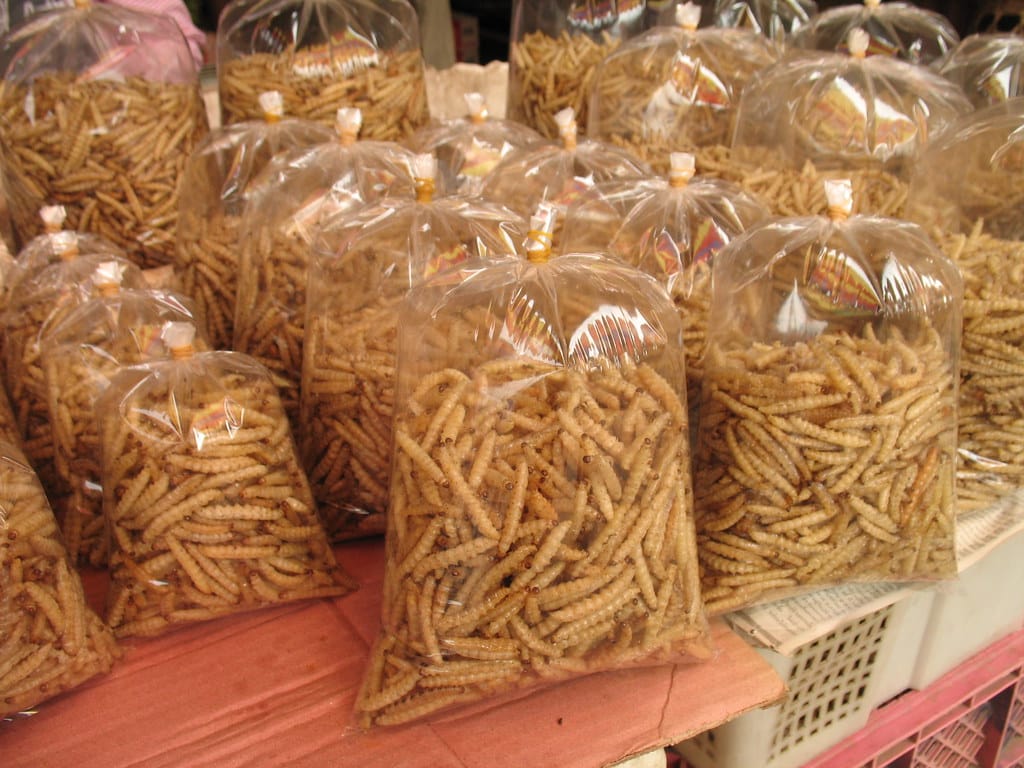
Bamboo worms, also known as bamboo caterpillars, are a popular delicacy in Southeast Asia, especially in Thailand, Laos, and Vietnam.
These worms are the larvae of a species of moth called the bamboo borer.
Bamboo worms are usually harvested in the rainy season when they are abundant in bamboo forests.
They are then cleaned, boiled, fried, served as a crunchy snack, or used as an ingredient in various dishes.
Bamboo worms are rich in protein, vitamins, and minerals such as calcium, iron, and magnesium.
Also, they are low in fat and carbohydrates, making this insect a healthy and nutritious food choice.
Although bamboo worms may not be commonly eaten in the Western world, they are considered a tasty and sustainable food source in many Southeast Asian cultures. Bamboo is one of the different types of insects that people eat.
12. Mopane Worms
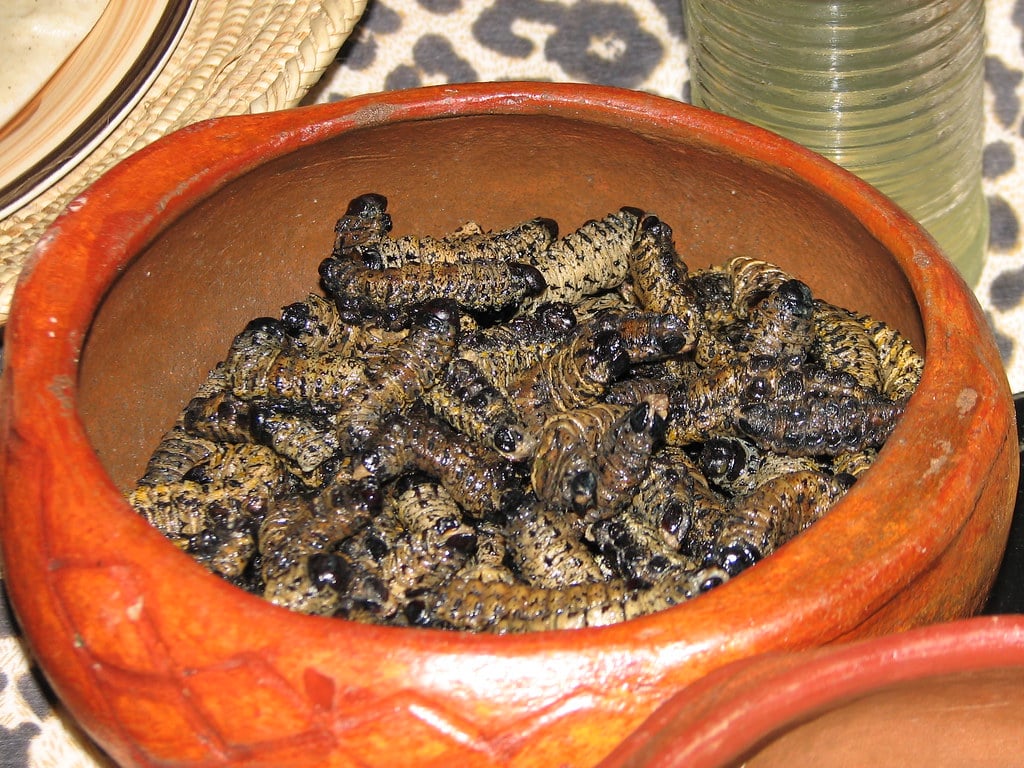
Mopane worms, also known as emperor moths or Gonimbrasia belina, are a beloved delicacy in Southern Africa, particularly in Botswana, Zimbabwe, Namibia, and South Africa. These worms are the caterpillars of the emperor moth and are harvested in large numbers during the rainy season.
Mopane worms are a highly nutritious food source, with high protein and low-fat levels.
They are traditionally prepared by being smoked, boiled, or dried and can be consumed as a snack or part of a main meal.
Additionally, they can be ground into a paste and used as a seasoning.
For many rural communities, harvesting and selling mopane worms is an important source of income.
Moreover, harvesting the worms helps preserve the mopane tree, a significant source of the region’s firewood, charcoal, and building materials.
Although some may be hesitant to try them, mopane worms, one of the different types of insects that people eat, are considered a delicacy and are enjoyed by many people in Southern Africa.
They have a unique nutty and buttery flavor and a satisfying crunchy texture. So, if you can try them, don’t hesitate to indulge in this tasty and nutritious treat. Mopame is one of the different types of insects that people eat.
13. Witchetty Grubs
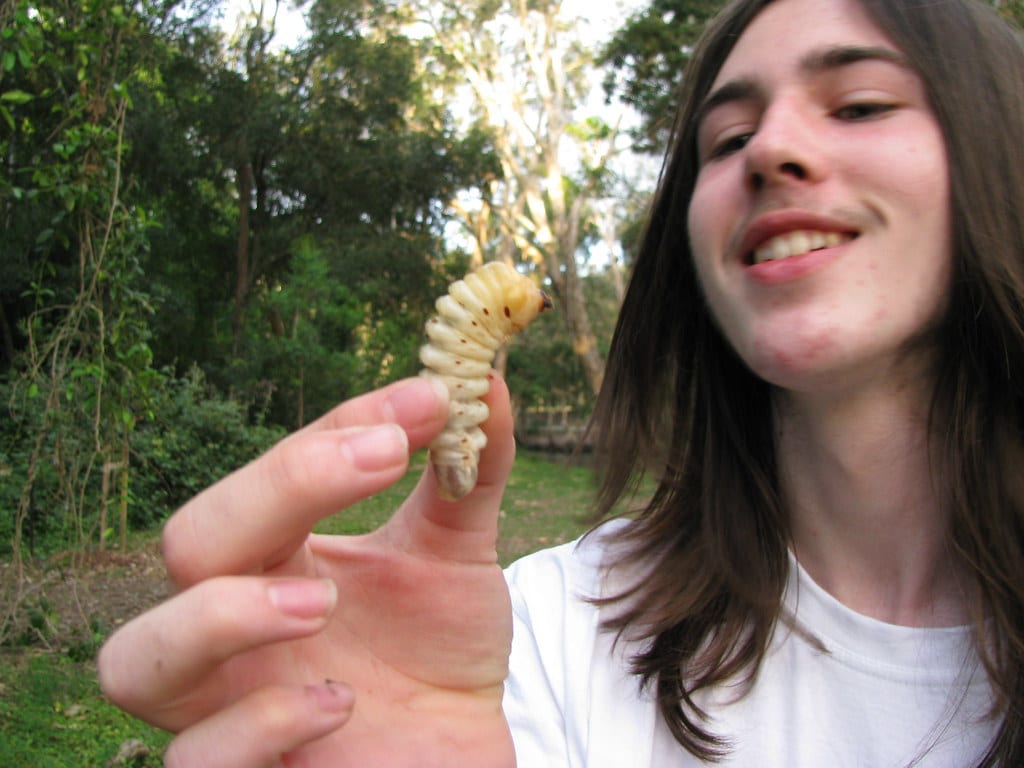
Witchetty grubs, one of the different types of insects that people eat, are a popular food source in Australia, particularly among Indigenous communities.
These plump, cream-colored larvae can grow up to 12 centimeters long and are found inside the roots of the witchetty bush, a type of Australian acacia tree.
To prepare the grubs, they are typically lightly roasted or eaten raw after being peeled.
They have a nutty, buttery flavor and a soft, slightly chewy texture.
Witchetty grubs are considered a nutritious food source, as they are rich in Amino protein, fats, and important minerals such as iron and calcium.
Also, they are low in carbohydrates, making this insect a good option for those following a low-carb diet.
Additionally, witchetty grubs have a long shelf life and can be dried or smoked for later consumption.
Although they may not be a common food in Western cultures, witchetty grubs have been a staple of the Australian diet for thousands of years and are an important part of Indigenous culture and cuisine. This is one of the different types of insects that people eat.
14. Silk Moth Pupae
Silk moth pupae, also known as ‘silkworm chrysalis,’ are commonly consumed in various parts of the world, particularly in Asia.
These pupae are a byproduct of the silk industry, which mainly involves raising and harvesting silk worms for their silk production.
Silk moth pupae have a nutty and creamy flavor with a chewy texture, making them a popular ingredient in soups, stews, and even as a snack. They are also highly nutritious, with a high protein content and low in fat.
In some countries, silk moth pupae are considered a delicacy and are served at special occasions such as weddings and festivals.
Furthermore, they are also believed to have medicinal properties, and these insects are used in traditional medicine to treat various ailments.
While silk moth pupae may be less commonly consumed in the Western world, they are gaining popularity as a sustainable and protein-rich food source.
They are considered an eco-friendly alternative to traditional livestock farming due to their low environmental impact and high nutritional value. Silk Moth is one of the different types of insects that people eat.
15. Stink Bugs

Stink bugs are a type of insect that is commonly found in gardens and farms around the world.
They are known for their strong odor, emitting as a defense mechanism when threatened.
Although stink bugs are often considered a nuisance to farmers, they are consumed as food in many cultures.
In Japan, for example, stink bugs are roasted and eaten as a snack, while in some parts of Africa, they are boiled and served in stews.
Furthermore, Stink bugs are a good source of protein and other nutrients; some people believe they have medicinal properties.
However, not all species of stink bugs are safe to eat, and some may even be poisonous.
If you are interested in using stink bugs as a food source, it is recommended to seek guidance from a local expert to ensure that you consume a safe and properly prepared species.
Stink Bugs are one of the different types of insects that people eat.
16. Wasps

Wasps are flying insects from the order Hymenoptera, including bees and ants.
Also, they can range in size from small to medium-sized and have slender body with a narrow waist.
Wasps can be found worldwide and play an important role in pollination and pest control.
While many species of wasps are solitary and not harmful to humans, some can be aggressive and deliver painful stings.
However, despite their reputation as pests, some cultures worldwide consume wasps as a food source.
In Japan, wasp larvae are considered a delicacy and are often used in traditional dishes.
The nests are carefully opened to harvest the larvae, and the grubs are removed and rinsed to remove any remaining debris.
The larvae can be eaten raw or cooked with a nutty flavor like almonds.
Wasps are also used in traditional Chinese medicine for their anti-inflammatory and analgesic properties.
In addition to their various culinary and medicinal uses, wasps have also been studied for their potential as a renewable energy source.
Some researchers have investigated using the sugar content found in wasp larvae as a potential biofuel source. Wasps are one of the different types of insects that people eat.
17. Centipedes

Centipedes are arthropods, one of the different types of insects that people eat that belong to Chilopoda, characterized by long, segmented bodies and numerous pairs of legs.
While centipedes are often considered pests, some cultures worldwide consume certain species as food.
In particular, the Scolopendra subspecies is a centipede species commonly consumed in China, Vietnam, and other parts of Southeast Asia.
These centipedes are typically fried or roasted and seasoned with various spices to enhance their flavor.
The legs and head are removed before consumption, and the remaining body is chopped into small pieces.
While some people may find eating centipedes unpalatable or frightening, they are a good source of protein and other essential nutrients.
However, it is incredible to note that some species of centipedes can be venomous, so caution should be exercised when selecting and preparing them for consumption.
18. Dragonflies

Dragonflies are an insect found in almost every region of the world, with over 5,000 known species.
Despite being a common sight around freshwater sources, ponds, and streams, dragonflies are not often considered food sources in Western cultures.
However, dragonflies are eaten in some parts of the world as a delicacy.
In Indonesia, for example, deep-fried dragonflies are a popular snack and can be sold on street food carts.
In Japan, a dish called “Ago-no-karashi-sumisoae” features boiled dragonflies in vinegar and miso sauce.
While dragonflies are not considered a staple food source, they are also a very good source of protein and are often eaten in times of scarcity or famine.
Additionally, some cultures believe dragonflies have medicinal properties and are used in traditional medicine. Dragonflies are one of the different types of insects that people eat.
19. Locusts

Locusts are grasshoppers in many parts of the world, particularly in Africa, the Arabian Middle East, and Asia.
They are known for their ability to swarm and migrate in large numbers, causing significant damage to crops and vegetation.
However, locusts are also a food source for many people in these regions.
They are rich in protein and can be cooked and prepared in various ways. In some countries, locusts are even considered a delicacy.
Locusts can be boiled or fried and often seasoned with salt, pepper, and chili powder.
Some people also roast locusts or grind them into a powder you can use as a cooking ingredient or add to other dishes.
While eating locusts may seem strange or unappetizing to some, they are a nutritious and sustainable food source that has been part of human diets for thousands of years.
Conclusion
In conclusion, while consuming insects may be unfamiliar or distasteful to some, insects have been a traditional and important food source in many cultures for centuries.
In addition to their cultural significance, insects offer a sustainable and nutritious alternative to traditional protein sources, and their consumption can provide economic benefits to local communities.
As the world faces increasing environmental challenges and growing demand for protein, insects are becoming an increasingly important and viable option for food production.
The popularity of insects as food is on the rise, and it will be interesting to see how this trend evolves in the coming years.




